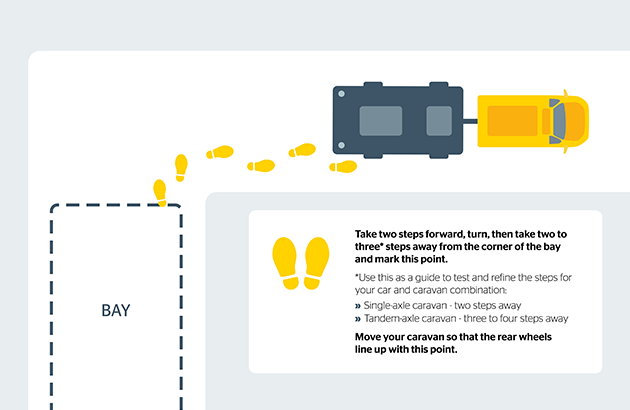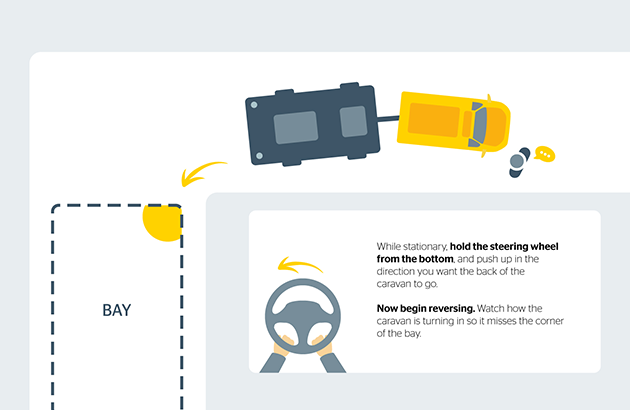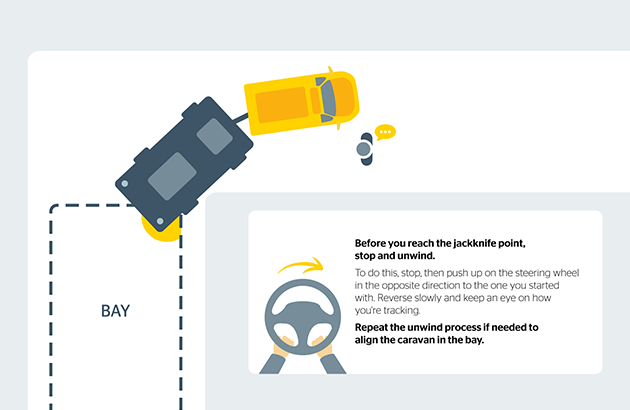Travel & Touring | Camping & Caravanning
To many first-time owners, reversing a caravan is one of the trickiest and most intimidating manoeuvres to perform.
Reversing a caravan with a spotter
Reversing a caravan solo
Reversing your caravan safely and effectively requires practice, but it gets easier over time. Caravan expert Mike Sandilands from Driver Risk Management takes us through the steps. Follow his instructions to practice reversing your caravan before your next trip away.
General reversing rules
It's always easier to reverse to the driver's side, so plan your approach.
Make all steering adjustments while stationary. Stop, adjust, check - come to a halt, make an adjustment, and then move a little bit.
Most importantly, take it slow, the faster you go, the more likely you are to get out of shape.
Note - if you have bikes stored at the front of your caravan on a rack, make sure to take them off before you start because this will cut down your turning angle when reversing.
Steps for reversing into a caravan park
Follow Mike's step-by-step guide to learn how to safely and effectively reverse your caravan into its caravan park bay.
Step 1 - Choose your spotter
The spotter is the most important role, so have the most experienced person stand out in the front of the vehicle. They'll have a better appreciation of where the caravan is going to go and what it's going to do.
Step 2 - Agree on your hand signals
The key is to have open and clear communication so that there's no confusion. Never stand behind a caravan when it's going backwards - it's very dangerous. The safest place for the spotter is to be at the front.
As the driver, hold your hands at the bottom of the steering wheel. All steering movements will be made while the car is stationary, and are going to be either full lock to the left, full lock to the right, or straight wheels. All you need to do then is just adjust how far you move.
Mike recommends the following signals:
| To move the back of the caravan in a certain direction |
|
| Signal straight wheels |
|
| To help position wheels straight |
|
| Signal to stop |
|
| Signal to reverse |
|
| Signal to come forward |
|
Step 3 - Check the space
When you arrive, hop out and inspect the bay. Look for obstacles or anything that you're likely to run over, and the location of your services. Remember to leave enough room for your annex or awning if you have one and a little bit of extra space for when you step outside. Some caravan parks will have a concrete slab. You want to reverse in as close to this slab as possible, so you don't have to jump from your step to the slab.
Step 4 - Mark your turn-in point
The turn-in point is measuring where your caravan's rear wheels should be, as this is the pivot point from which it will start turning. Every vehicle and caravan combination is different, and each will turn in at a different rate, so it's important to identify the turn-in point for your caravan as this will make it easier to get it into the bay.
First, identify the corner of the bay that you're reversing into. You don't want to be too close to the side of the bay, so we recommend being at least two paces out.
Use this as a starting point and refine it from there:
- For a single-axle caravan, take 2 steps away from the corner of the bay and mark this point
- For a tandem-axle caravan, take 3 steps away from the corner of the bay and mark this point
This is the point where you need to start to turn the caravan in, so move your caravan so that the rear wheels line up with this point.
When you go to reverse, if you find the caravan cuts into the corner, take one less step so that it turns in a little later and misses the corner. If you find that it turns in and ends up in the middle of the bay, take an extra step away from the corner so that it brings your turn-in point earlier and will move it closer to the side of the bay.

Step 5 - Reversing into the bay
Once the rear wheel reaches the turn-in point, the spotter will stop the vehicle, and then point in the direction that they want the back of the caravan to go.
As the driver, push up on the steering wheel in the direction that the spotter is pointing. The spotter should check that the front wheels are pointing in the opposite direction to which they are pointing.
Once happy with the steering direction, the spotter will motion for the driver to start moving backwards and the caravan will start turning in the pointed direction into the bay. The spotter should watch how the caravan is turning in so that it is missing the corner of the bay.
If it turns in too quickly, the spotter should signal to stop, and change the wheel direction to straight wheels. This will slow down the turn rate but will still turn the caravan into the bay.
The spotter again signals to go backwards, watching the way the caravan is turning, and stopping the vehicle before it jackknifes.

Reaching the jackknife point
One thing that we don't want to occur whilst reversing the caravan is a jackknife. A jackknife occurs when we start turning the caravan into the bay, and then the back of the vehicle comes into contact with the front of the caravan, and causes damage to either or both.
To manage this from a spotter's perspective, while standing at the front of the vehicle, look straight down the side of the vehicle and identify a particular feature on the front of the caravan that appears before the point of jackknifing. Stop when that feature comes into view.
From the driver's perspective, look in the vehicle wing mirror, straight down the side of the car. Once the back of the car lines up with the feature you've identified for your car and caravan combination, stop.
Before you reach the jackknife point, stop and unwind. The spotter will now point in the opposite direction to the one indicated originally. The driver will push up on the steering wheel in the opposite direction to the one you started with. Reverse slowly, and repeat the unwind process if needed to align the caravan in the bay.
Once the caravan is in the bay, the spotter should walk to the back of the caravan to work out how far back to go. Pace the distance out, and then return to the driver's door. From the driver's door, pace this distance towards the caravan, stand still and tell the driver to reverse back until they are level with the spotter. If you're solo, pace the distance out yourself and place a mark on the ground. Reverse until your driving position is level with that mark.

Fixing suspension twist on a tandem axle caravan
When turning a tandem axle caravan around a corner, each of the wheels travels a different distance, causing a significant twist into the suspension. That twist is projected into the subframe of the caravan and through to your tow hitch. The force against your tow hitch can make it very difficult to remove. A simple fix is, once you have the caravan in position, drive forward and back again to remove the twist.
Step 6 - Secure your caravan
Once you are happy with where the caravan is positioned and that it's level, you need to secure it. Apply the caravan park brake, and chock a wheel if necessary. Then go through the process of disconnecting it.
A simple re-cap on the steps
- Identify the spotter
- Agree on your hand signals
- Check the bay to make sure it's clear of obstacles
- Pace and mark out your turn-in point
- For the driver, keep your hands at the bottom of the wheel and push up in the direction that your spotter is pointing
- The caravan will track around the corner and end up where you want it to be
- Once it's positioned, secure your caravan so it's not going to go anywhere
- Apply the park brake and chock the wheels if you need to
Remember, practice is the key. The more you practice, the easier it gets.
Need some more beginner's caravan advice?
We're running free 2-hour caravan safety sessions to help you prepare for your next trip.
